From 4-lane road to linear art park
由专筑网pilewyj,小R编译
乌得勒支近日对城市的一条主干道进行了改造。Croeselaan街原本是一条四车道路,是通往市中心的重要途经。然而,在20世纪70年代初设计时,当时人们慢行交通的考虑十分缺乏,这一点现在已经有所进步了,目前大部分街道都是为人们而服务。Croeselaan街的重新设计也尽可能考虑到环保问题。6月份,这条艺术线路的开通,标志着目前对车站区域的重新设计的开始,毕竟这是一个长期、持续的过程。
Utrecht has reconstructed yet another arterial road. The Croeselaan was a 4-lane road, leading to an area in the city that had been designed with only the private car in mind in the early 1970s. That has completely changed. Most of the street level is now dedicated to people. The redesign of Croeselaan is as environmentally friendly as possible. The opening of an art route, last Friday, marked just one step in the current redesign of the station area, a process that is far from finished.
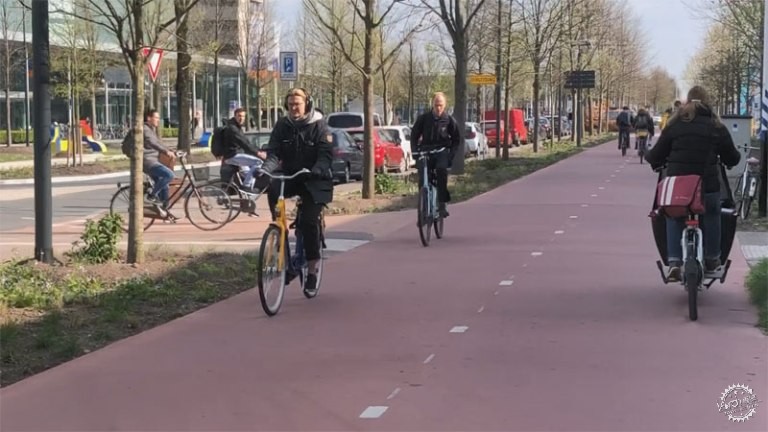
4.5米宽的自行车道,具有环保的混凝土表面/The new 4.5 metre wide main cycle route on Croeselaan with a special (environmentally friendly) type of concrete surface.
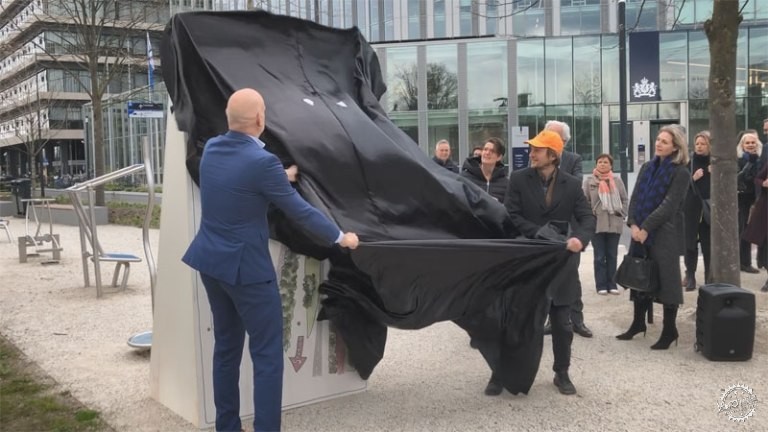
负责重建站区的Victor Everhardt市议员与Croeselaan居民(图右)共同为这条艺术路线的信息板揭幕/Alderman Victor Everhardt for the reconstruction of the station area unveils an information board about the art-route with a resident (right) of the Croeselaan.
乌得勒支火车站街区经过近10年的重建,部分地块即将完工。今年8月下旬,世界上最大的自行车停车场的最后施工阶段将在5月开放的东区车站广场进行收尾工作。在车站的西侧,Jaarbeursplein广场(展览和会议中心广场)的大部分重建工程已经完成,通往该站的Croeselaan街的施工亦是如此。Croeselaan街曾经是一条4车道的机动车道路,边侧有单向自行车道,但到了Jaarbeursplein广场的时候,机动车交通就变得混乱。Croeselaan街变得拥堵非常,因为每个方向只有一条行车道,速度降低了30公里/小时。进行重建后,道路将通向地下停车场的入口处,在那里道路得到分流。这个车库缓解了过去在广场上肆意停车的状况。随着那座建筑和以机动车为导向的路线的消失,Jaarbeursplein广场将不再有机动车穿行。人们可以更好地享受步行。广场可以容纳人们散步,也可以让人们在这里进行各种活动。在通往车站大厅的Jaarbeursplein广场自行车停车场的台阶上,也可以成为人们停坐的空间。街道上行人的角色得以强调。自行车路线将升级为4.5米宽的双向独立自行车道路,中间成为线性公园。许多树木种植于此,艺术雕塑也在这里找到新家。这条艺术步行街的开放将为更多的城市空间创造机会。
After nearly 10 years of reconstruction in the Utrecht Station area finally some parts of it are nearing completion. Later this year, in August, the final part of the largest bicycle parking in the world will be opened under the station square on the east side that will open in May. On this west side of the station, most of the reconstruction of Jaarbeursplein (Exhibition and Convention Centre Square) was finished now and so was the Croeselaan leading to it. The Croeselaan used to be a 4-lane through road with one way cyclepaths next to it, but motor traffic can no longer continue on Jaarbeursplein. Croeselaan became a dead-end street with just one travel lane in each direction and a reduced speed of 30km/h. The reconstructed road ends in the entrance of a new underground parking garage. This garage came in the place of the brutalist multi-storey building that used to house car parking on the square. With that building and the through route gone there no longer is a car traffic flow on Jaarbeursplein. This makes it possible to walk from the central station to the halls of the convention centre without having to cross car traffic. The new design of the square turns that walking route into a very attractive stroll. The new square can also be used for events. A large audience can take place on the steps over the Jaarbeursplein Bicycle Parking Garage that lead to the station hall. The extra space that became available on Croeselaan has also been dedicated to people. The main cycle route became much more recognisable as a 4.5 metre wide bi-directional separate cycle road. The former median became a linear park. Many mature trees were relocated here and works of art, which had to make way for a number of redevelopments elsewhere, also found a new home at this location. The art walk was opened last Friday by the alderman for the redevelopment of the station area, Victor Everhardt, together with a resident.
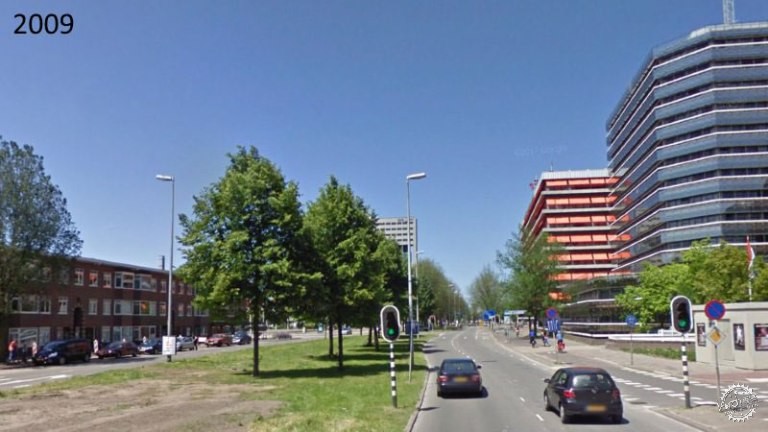
从1971年到2012年,该街道是一条四车道的公路/The Utrecht Croeselaan in its form from 1971 to 2012, a 4-lane road. (Picture Google Streetview)
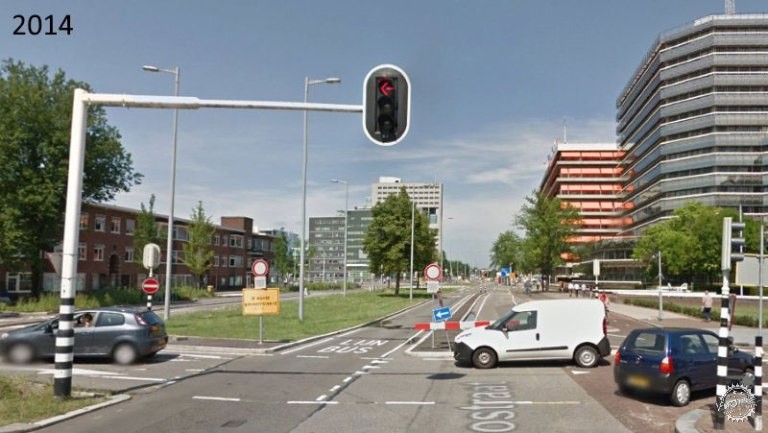
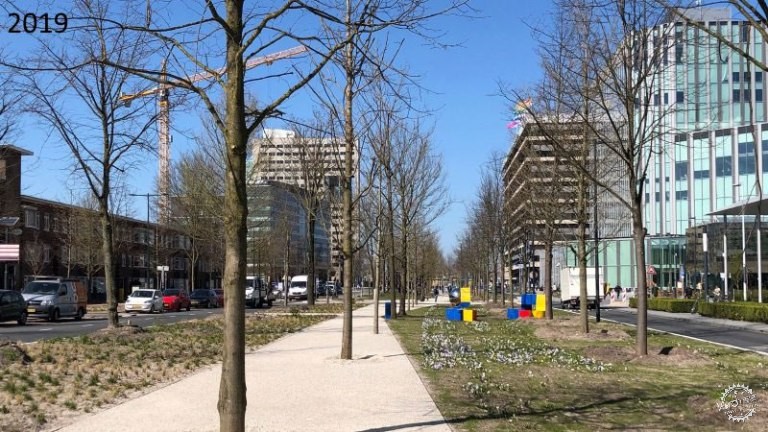
2019年的Croeselaan街。在一个有长椅、101棵新树和许多艺术作品的线性公园里,这个空间完全开放,属于大众/The Croeselaan in 2019. With 101 new trees and a number of art works in a linear park with benches, the space has truely been given back to people.
Croeselaan街的改造工程始于2011年,有些树经过了移植,另一些树则被砍伐。2012年,大部分树木清理完工,道路工程真正开始。由于通往站区的管道和电缆必须更换,这条街在一段时间内无法使用,Jaarbeursplein广场的停车场被拆除,并为新的地下车库挖了地基。
The reconstruction of Croeselaan had started in 2011 when the first trees were removed. Some could be relocated to other places in the city. Other (unhealthy) trees had to be cut. In 2012, more trees were (re)moved and the road works really started. Pipes and cables leading to the station area had to be replaced and the street was already then turned into a dead-end street. The parking garage on Jaarbeursplein was demolished and a large hole was dug for the new underground garage.
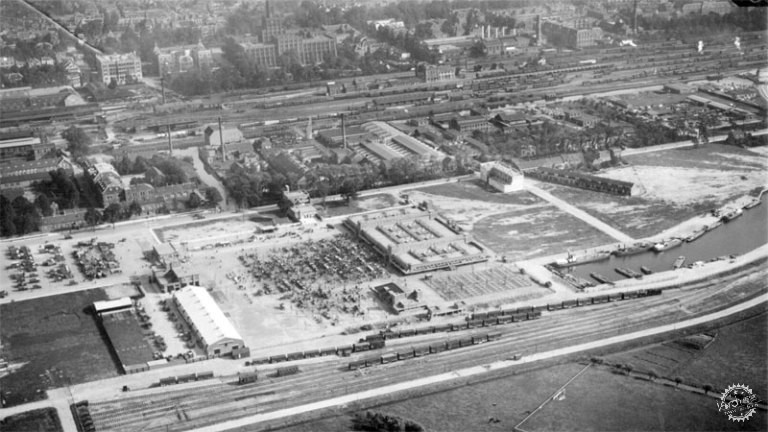
1928年,Croeselaan街当时新牛市场的航拍照片。在20世纪60年代,市场搬迁,为会议中心(jaarbeurs)腾出了空间。在图片的上半部分、铁路轨道后面,是乌得勒支市中心的方向,荷兰铁路公司的三座总部大楼清晰可见。图片来源:KLM Aerocarto, Het Utrechts Archief/Aerial picture of the then new cattle market (partly covered in a hall) on Croeselaan in 1928. The market moved away from here in the 1960s, making room for the Convention Centre (Jaarbeurs). In the top half of the picture, behind the railway tracks, you can see the Utrecht city centre. Clearly visible are the three headoffice buildings of the Dutch Railways. Picture (KLM Aerocarto, Het Utrechts Archief)
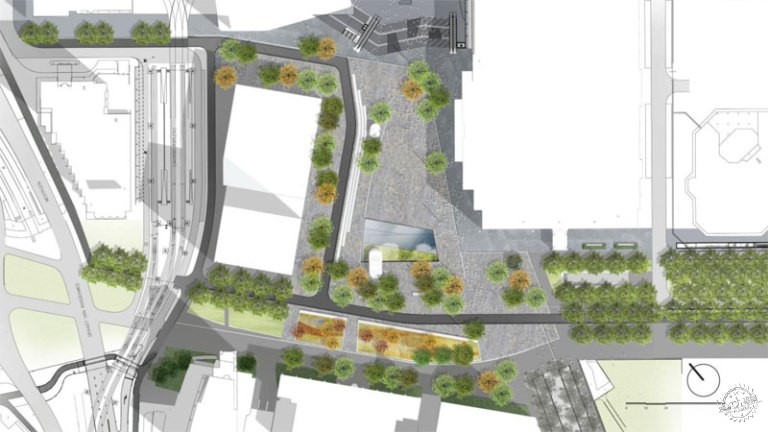
Okara景观设计事务所为场地进行了新设计。白色矩形(左中)是尚未建成的高层建筑的位置。在最左边,场地连接了20世纪60年代设计的宽阔道路系统。这条道路不再连接到右边的Croeselaan街道,其入口现在有着许多树阵和深灰色的新自行车道,但实际施工中,自行车道应该是红色的。图片来源:Okra/The design for the new Jaarbeursplein by Okra. The white rectangle (centre-left) is the location of a high-rise that has yet to be built. On the far left you can see the wide road system designed in the 1960s. This road no longer connects to Croeselaan on the right where you can see it’s entrance now has multiple lines of trees. The new cycleways are dark gray here, but in reality they became red as they should be. Picture Okra.

2007年的航拍照片,当时该地块是街区的核心地带。图片来源:谷歌地球/IAerial picture from 2007 when the Croeselaan and Jaarbeursplein were first and foremost a main arterial. (Picture Google Earth)
这并不是该地区的第一次改造。这里其实离历史上的老市中心很远,这里曾经是大型军营所在地,也是城市的牛市。上世纪60年代,牛市场逐渐迁出城镇,后来,军营也被重新安置。这使得这个位于中央车站以西的大块用地成为乌得勒支会议中心的理想位置,而乌得勒支原有会议中心曾经一直位于Vredenburg。搬到这个偏离中心的地方之后,会议中心也有了更多的停车空间。在目前的重建中,会议中心巨大的停车场会被搬走,移到展览馆的西侧。取代老停车场的是新高层建筑,因此,会议中心又一次被迁往离市中心更远的地方。
It was not the first time this area of the city was redeveloped. Since this used to be a long way from the historic city centre this was where large military compounds were located and the city’s cattle market. The cattle market was moved much further out-of-town in the 1960s and later the military compounds were also relocated. This made this vast area just west of the central station available for the Utrecht Convention Centre that had been located on Vredenburg up to that time. They moved to this “out of the centre” area to have more space for car parking. In the current redevelopment the Convention Centre’s vast parking areas were moved further out-of-town to the west side of the exhibition halls. The former parking lots are now being developed with a lot of high rises. So the Convention Centre is pushed further out-of-town, as it were, once again, although most of its exhibition and convention halls stay in much the same place.
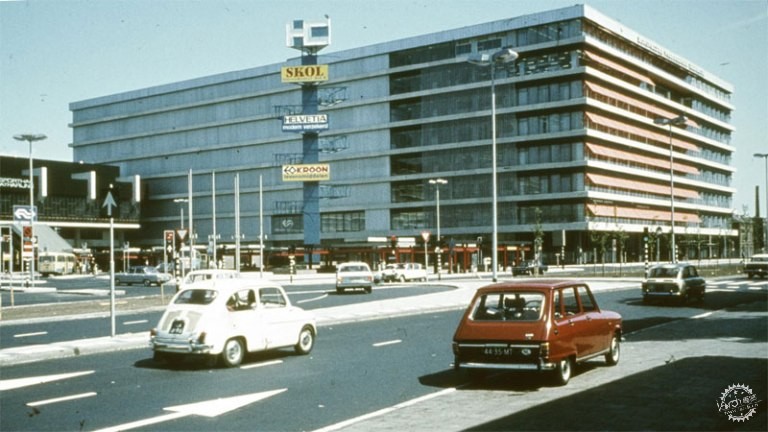
1972年位于Jaarbeursplein广场的会议大楼。建筑周边几乎所有的公共空间都是专用于私家车的场所。图片来源:J.C. Janssen, Het UtrechtsArchief/The convention building on Jaarbeursplein around 1972. Almost all the public space was dedicated to the private car. (Picture J.C. Janssen, Het UtrechtsArchief)
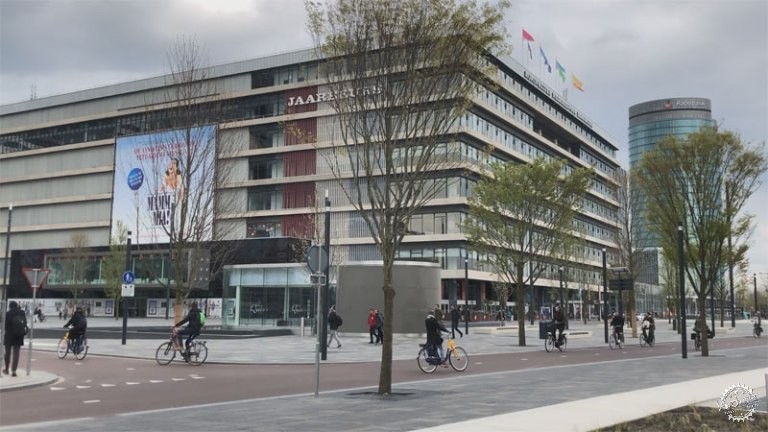
2019年的新主会议厅、剧院大楼、主自行车道、新行道树和步行空间/The main convention hall/theatre in 2019 with the main cycle route, new trees and the walking route from the station (left) to the exhibition halls to the right.
乌得勒支市以可持续的理念重新设计了Croeselaan街,路灯由太阳能驱动,交通标志则是竹制,因为这种材料生长快,还能吸收大量二氧化碳。车道路面部分由回收材料制成,而自行车道的表面则由一种环保材料制成。场地中的土壤也得以重新利用,与堆肥混合,使之用于新公园,这意味着不需要很多卡车来运输新土壤。许多树木来自城市的其他地方,而且原本无处安放的艺术品也在这里得到安置。
这8件艺术品于2019年3月展出。1971年,3件艺术品放置在Jaarbeursplein广场道路的中间带。由于这些中央带的撤销,这些被安置在带状公园的青铜器仿佛来到了新家。公园位于荷兰合作银行总部前方,银行也为公园捐赠了两件艺术品。除此之外,市政府组织了新活动,其中有来源于Christian Jankowski的艺术作品“Living Sculptures”。这些艺术作品表达了那些在街道上一动不动地模仿青铜雕塑的表演者。雕像中有一座描绘了Che Guevara,也因此引起了争议。由于政治因素,因此这座雕像被涂上了红色油漆。后来雕塑得到清洗和保留,在接下来的发展中,这座雕塑似乎成为了流行文化的象征,而不仅仅代表了其自身。
The city of Utrecht redesigned the Croeselaan in the most sustainable way possible. The street lights are solar-powered. The traffic signs are made of bamboo, because that wood grows quickly while absorbing a lot of CO2. The surface of the car lanes was partly made of recycled material and the cycleway surface is made of a type of concrete that requires less cement, so its construction leads to less CO2 emissions. Even the not so fertile original soil of the median was reused, mixed with compost it became suitable for the new park. This meant many truck rides to bring new soil were not necessary. A number of trees came from other places in the city and also the art was recycled. The street now has more trees than there were before the reconstruction.
The 8 works of art were placed in March 2019. Three works of art had been made for the medians of the Jaarbeursplein roads in 1971. Since those medians no longer exist these bronzes found a new home here. The park is right in front of the headoffice of Rabobank. That bank donated two works of art. The city also placed works that were more recently required. One of which is “Living Sculptures” by Christian Jankowski from 2007. The three bronzes portray street performers who in turn mimic bronze sculptures by standing motionless in the street. One of these three statues depicts Che Guevara, which led to controversy. Right wing politicians protested against “the glorification of this Marxist terrorist” and the statue was consequently smeared with red paint. But it was cleaned and will stay. The city does consider a sign explaining that this is a statue of someone pretending to be Che, who became an emblem in popular culture, it is not meant to glorify the man himself.

1972年Jaarbeursplein广场。目前位于假日酒店前的五层停车场已经被拆除。图片来源:Publicam, Het Utrechts Archief/Jaarbeursplein in 1972. In front of the Holiday Inn hotel the five-storey parking garage that has been removed now.(Picture Publicam, Het Utrechts Archief)

2019年Jaarbeursplein街。以前的办公大楼已被拆除,广场的大部分街道正在进行重新设计/Jaarbeursplein in 2019. Where the parking garage used to be a new high-rise will be built. Two-thirds of the brutalist office building right from the hotel has also been demolished. Most of street level of the square has now already been redesigned.
那么Jaarbeursplein广场和Croeselaan街现在竣工了吗?还为时尚早!在Jaarbeursplein广场,临近的两座高层建筑依然还在建设中,Croeselaan街的住宅区将被拆除,以便为今后的高层建筑和便捷的慢行交通系统腾出空间,方便人们的出行。但如今,曾经的一些建筑工地已经成为人们心神向往的美丽场所。在未来的这十年里,乌得勒支很多人都对这项工程充满期待。
So are Jaarbeursplein and Croeselaan finished now? Far from it! On Jaarbeursplein two highrises are currently under construction and a whole block of housing will be removed on Croeselaan to make room for even more tall buildings and better connections (mainly for cycling) from the Moreelsebrug for walking and cycling to a new residential area further west. But at least some of the building sites have become more beautiful places for people now. After a decade of building activities that was what a lot of people in Utrecht were longing for.
|
|
